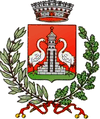Portogruaro
| Portogruaro | ||
|---|---|---|
| Comune | ||
| Comune di Portogruaro | ||
 | ||
| ||
 Portogruaro | ||
| Coordinates: 45°47′N 12°50′E / 45.783°N 12.833°E | ||
| Country | Italy | |
| Region | Veneto | |
| Province | Venice (VE) | |
| Frazioni | Giussago, Lison, Lugugnana, Portovecchio, Pradipozzo, Summaga | |
| Government | ||
| • Mayor | Antonio Bertoncello (Centre-left) | |
| Area | ||
| • Total | 102,22 km2 (3,947 sq mi) | |
| Elevation | 5 m (16 ft) | |
| Population (31 May 2012)[1] | ||
| • Total | 25,876 | |
| • Density | 2.5/km2 (6.6/sq mi) | |
| Demonym | Portogruaresi | |
| Time zone | CET (UTC+1) | |
| • Summer (DST) | CEST (UTC+2) | |
| Postal code | 30026 | |
| Dialing code | 0421 | |
| Patron saint | Saint Andrew | |
| Saint day | 30 November | |
| Website | Official website | |
Portogruaro is a town and comune in the province of Venice, Veneto, northern Italy.
History
Portogruaro was officially founded in 1140, when the Archbishop of Concordia, Gervinus, gave a group of fishermen the right to settle there and build a river port. A castle had existed on the site as early as the 10th century. In 1420 its citizens requested membership of the Republic of Venice. Under the Venetians the town retained some autonomy and was able to expand economically up until the economic decline of Venice from the 17th century onwards.
Following the upheavals of the Napoleonic Wars, Portogruaro was incorporated into the Austrian Empire in 1815. Apart from a brief uprising in 1848 Portogruaro remained under Austrian control until 1866 when it entered the newly unified Kingdom of Italy. Since that time the population of Portogruaro has grown from under 10,000 to around 25,000.[2]
Main sights
- Romanesque Abbey of Summaga (11th century). The church, built in 1211, has an 18th-century façade. The sacellum has frescoes from the 11th–12th centuries, depicting the Redemption, The Original Sin, The Punishment of Adam and Eve, the Crucifixion and the Final Judgement. The apse is also frescoed.
- Town Hall, a Gothic building from 1265, with a façade including later additions (c. 1512). It houses three paintings by Luigi Russolo.
- Mills on the Lemene river (12th century)
- Church of Sant'Agnese (13th century)
- Communal Villa, a 16th-century patrician residence
- A series of 14th–15th-century palaces
The Roman and medieval city of Concordia Sagittaria was located nearby.
Economy
The main activities include the production of wine. A former large phosphates producer is now closed.
Sport
The local football club is called Calcio Portogruaro Summaga, founded in 1990, and plays in the third Italian league (Lega Pro).
Twin towns
 Marmande, France, since 1987
Marmande, France, since 1987 Ejea de los Caballeros, Spain, since 1987
Ejea de los Caballeros, Spain, since 1987
References
- ↑ Population data from Istat
- ↑ "Censimenti popolazione Portogruaro 1871-2011" (in Italian). www.tuttitalia.it. Retrieved 15 December 2012.
External links
| Wikimedia Commons has media related to Portogruaro. |
- Official website
- Webcam in Piazza della Repubblica
- Satellite image from Google Maps
- Museo Nazionale Concordiese in Portogruaro
